| |
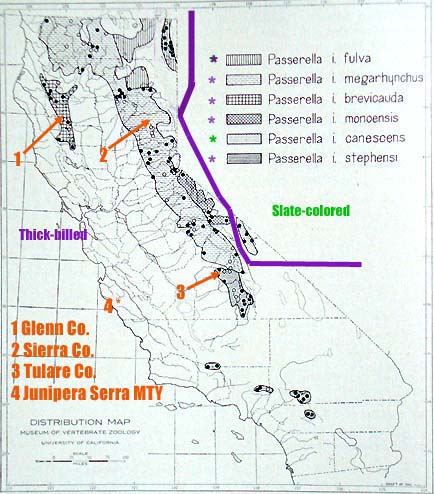 The five subspecies** in the Thick-billed Fox Sparrow
group breed mostly within California. This map from Grinnell &
Miller (1944) illustrates the approximate ranges of these five
subspecies [races indicated by purple stars in the legend and breeding
west or south of the purple line on the map] as well as the approximate
breeding ranges of the one subspecies within the Slate-colored group
that nests in California [east of the purple line; indicated by green
stars in the legend]. Small details of this map may be slightly
different now, but the overall picture is reasonably accurate. The five subspecies** in the Thick-billed Fox Sparrow
group breed mostly within California. This map from Grinnell &
Miller (1944) illustrates the approximate ranges of these five
subspecies [races indicated by purple stars in the legend and breeding
west or south of the purple line on the map] as well as the approximate
breeding ranges of the one subspecies within the Slate-colored group
that nests in California [east of the purple line; indicated by green
stars in the legend]. Small details of this map may be slightly
different now, but the overall picture is reasonably accurate.
I've
indicated by orange arrows or stars four locales, dealing with 3
different subspecies, that will be discussed on this page.
**
Note: few authorities agree on the specific subspecies within each
group. I mostly follow Weckstein et al. (2002) but there are problems.
Although Weckstein et al. (2002) lists mariposae among the Thick-billed races, but they note that both Zink (1986) and Rising (1996) synonymized it with megarhyncha, so they really don't really recognize it at all.
Weckstein et al. (2002) does recognize fulva
(breeds e. Oregon/Warner Mts. CA) and monoensis (breeds eastern Sierra
in Alpine & Mono counties, and in Mineral Co., NV, as Thick-billed
subspecies, but Zink (1986), Pyle (1987), and Unitt (2002) merge both into megarhyncha. Rising (1996) does not. Rising (1986) and Weckstein et al. (2002) note that both monoensis and fulva
have bills that are intermediate in size between the primary
Thick-billed populations and the smaller-billed birds in the
Slate-colored group. Thus the populations in the Warner Mts and on the
east flank of the Sierra in Alpine & Mono counties are a bit
mysterious and remain little known and taxonomically controversial. |
The identification of most Thick-billed Fox Sparrow is well illustrated with the bird shown below [P. [m.] brevicauda; photo 18 June 2006 near Plaskett Meadow, Glenn Co. © D. Roberson]. It has a huge bill, both thick and deep, and the color of the lower mandible is gray or olivey-gray (not bright yellow-orange). The face is very plain. The back head and back are grayish, and contrast with rusty-red tail and wings. The underparts are rather lightly spotted for a Fox Sparrow. And the call is a loud chink!, recalling California Towhee (Garrett et al. 2000). |
|
|
|
Three subspecies that breed west of the Sierran divide are shown in this photo grid, and key to the numbers of the map:
- P. [m.] brevicauda
(above), which breeds from Yollo Bolla Mts., Trinity Co., south to Snow
Mt., Colusa Co. Photo 18 June 2006 near Plaskett Meadow, Glenn Co.
[© D. Roberson]
- P. [m.] megarhyncha
(above right), which breeds from sw. Oregon through the Siskiyous and
s. Cascades, and down the western flank of Sierra Nevada to near
Kearsarge Pass, Fresno Co. Photo 25 June 2009 at Yuba Pass, Sierra Co.
[© Tom Grey]
- P. [m.] stephensi
(right), which breeds on western flank of Sierra Nevada from Hume
Meadow, Fresno Co. through Tulare Co., and then at high elevation on
Mt. Pinos, through the San Gabriel Mts., San Bernardino Mts., and San
Jacinto Mts. to n. Baja California. Photo 12 May 2002 near Grant Grove,
Kings Canyon NP, Tulare Co. [© D. Roberson]
Not shown are P. [m.] fulva, which nests in e. Oregon & Warner Mts., CA, and P. [m.] monoensis, which nests along the eastern flank of the Sierra Nevada from Woodfords, Alpine Co., to Mammoth and Benton, Mono Co.
|
|
|
As
you can see, these three primary subspecies are rather similar. Each
has a big gray bill, plain gray head and back, and rusty wings and
tail. Unitt (2002) provided evidence that brevicauda and stephensi have the biggest bills (and synonymized them; more on that below), but megarhyncha is still very big-billed. It is apparently the races monoensis and fulva
that have bills intermediate in size between the Thick-billed and
Slate-colored groups, and may represent intergrade populations [the
race canescens in the White Mountains, sometimes synonymized with schistacea
in the Slate-colored group, is also said to be a bit intermediate;
Rising (1996)]. There are still some areas that are unsettled. Birds in
Onion Valley, Inyo Co., for example, are near Kearsarge Pass (said to
be megarhyncha; Weckstein et al. 2002) but I've been told that they are actually stephensi (T. Heindel, pers. com.).
|
 In
Monterey County there are at least four specimens that have been
assigned to the Thick-billed group, including this one (left) at Museum
of Vertebrate Zoology, taken at 2700' elevation at the head of Turner
Creek on 15 Sep 1934. It shows the big bill, gray back and red tail so
typical of Thick-billed Fox Sparrows. Alden H. Miller assigned it to
race brevicauda. Another similar specimen was collected on 15 Oct 1940 in Carmel Valley. In
Monterey County there are at least four specimens that have been
assigned to the Thick-billed group, including this one (left) at Museum
of Vertebrate Zoology, taken at 2700' elevation at the head of Turner
Creek on 15 Sep 1934. It shows the big bill, gray back and red tail so
typical of Thick-billed Fox Sparrows. Alden H. Miller assigned it to
race brevicauda. Another similar specimen was collected on 15 Oct 1940 in Carmel Valley.
Thick-billed
Fox Sparrows are notoriously early migrants (Garrett et al. 2000), so
the Sep-Oct dates for MTY records — earlier than the arrival of the
bulk of our Sooty Fox Sparrows — is consistent with known migratory
patterns. No Fox Sparrow is known to move north in winter, so
assignment to brevicauda from northwestern California also makes geographic sense. |
 There are two other specimens at MVZ, labeled "megarhyncha"
and collected in late December, which suggests the birds were
wintering. One is from Seaside, the other from Monterey. The latter
specimen, collected 19 Dec 1940, is the middle one at right, between
the MTY brevicauda specimen (above it) and a stephensi specimen (below it). Maybe it is just me, but the bill of that middle specimen just looks way too small to be megarhyncha, although the rest of the plumage seems okay. In general, it looks more like a schistacea Slate-colored Fox Sparrow to me in this photo. There are two other specimens at MVZ, labeled "megarhyncha"
and collected in late December, which suggests the birds were
wintering. One is from Seaside, the other from Monterey. The latter
specimen, collected 19 Dec 1940, is the middle one at right, between
the MTY brevicauda specimen (above it) and a stephensi specimen (below it). Maybe it is just me, but the bill of that middle specimen just looks way too small to be megarhyncha, although the rest of the plumage seems okay. In general, it looks more like a schistacea Slate-colored Fox Sparrow to me in this photo.
These
specimens have not been reviewed in detail in person; I took this photo
years ago to use as a study tool. But I do think that the two specimens
attributed to Monterey County in winter, and labeled megarhyncha, need further review. |
|
Most
intriguing is a record of a singing Fox Sparrow, atop Junipero Serra
Peak (above; photo 1 May 2004 © D. Roberson), found by Chris
Tenney on 20 June 1989 during the Breeding Bird Atlas project (Roberson
& Tenney 1993). This location is shown on the map above and labeled
#4. At this elevation — above 5000' — the habitat is not dissimilar to stephensi
Fox Sparrow breeding habitat on Mt. Pinos. It is possible that Fox
Sparrows may attempt to breed in Monterey County occasionally, and if
they do, we suspect they would be stephensi Thick-billed Fox Sparrows. |
Go to detailed pages on each Fox Sparrow group: |
|
|
|
|
|
|
| Opinionated commentary: Unitt (2004) lumps brevicauda into stephensi on the grounds that he could not diagnose specimens. P. i. brevicauda is said to be a bit browner and shorter-tailed the stephensi,
but Unitt states that specimens change color in museums, so the color
tone is not useful, and that tails are too ragged in summer to
accurately measure them. These statements may be true enough, but I
don't see how anyone can logically merge brevicauda from nw. California into stephensi of s. California, and leave megarhyncha,
which covers most of the range between them, as a different subspecies,
but Unitt (2004) does just that. No one has done the DNA analysis, but
just looking at the map it seems apparent to me that brevicauda and stephensi are not each other's closest relatives; stephensi merges into megarhyncha
in the southern Sierra, and seems surely more closely related to it
than to the isolated Fox Sparrow populations in extreme northwest
California. Under any semblance of taxonomic rules, the choices are to
split the three groups or merge them all, but the one thing that is not
possible is to merge brevicauda and stephensi and leave megarhyncha as a different taxa. |
|
Photos: All photos © Don Roberson, except as otherwise indicated; all rights reserved.
Literature cited:
- Garrett,
K.L., J.L. Dunn, and R. Righter. 2000. Call note and winter
distribution in the Fox Sparrow complex. Birding 32: 412-417.
- Grinnell, J., and A.H. Miller. 1944. The distribution of the birds of California. Pac. Coast Avifauna 27.
- Pyle,
P., S.N.G. Howell, R.P. Yunick, M. Gustafson, and D. DeSante. 1997.
Identification Guide to North American Passerines. Slate Creek Press,
Bolinas CA.
- Rising, J.D. 1996. A Guide to the
Identification and Natural History of the Sparrows of the United States
and Canada. Academic Press, New York.
- Roberson, D. 2002. Monterey Birds, 2d ed. Monterey Pen. Audubon Soc., Carmel, CA.
- Roberson,
D., and C. Tenney. 1993. Atlas of the Breeding Birds of Monterey
County, California. Monterey Pen. Audubon Soc., Carmel.
- Unitt, P. 2004. San Diego County Bird Atlas. San Diego Nat. Hist. Mus., San Diego.
- Weckstein, J.D., D.E. Kroodsma, and R.C. Faucett. 2002. Fox Sparrow (Passerella iliaca) in The Birds of North America, No. 715 (A. Poole & F. Gill, eds.). The Birds of North America, Inc., Philadelphia, PA.
- Zink, R.M. 1986. Patterns and evolutionary significance of geographic variation in the schistacea group of the Fox Sparrow (Passerella iliaca). Ornithol. Monogr. no. 40.
|
|
|


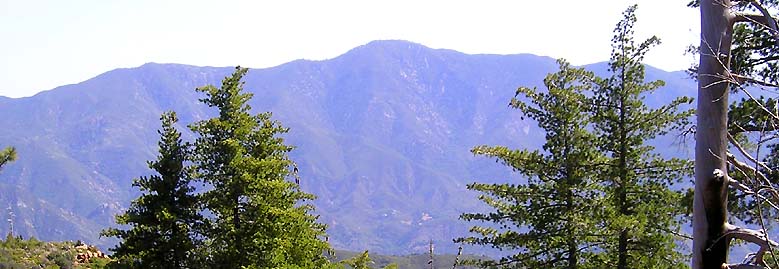
 The five subspecies** in the Thick-billed Fox Sparrow
group breed mostly within California. This map from Grinnell &
Miller (1944) illustrates the approximate ranges of these five
subspecies [races indicated by purple stars in the legend and breeding
west or south of the purple line on the map] as well as the approximate
breeding ranges of the one subspecies within the Slate-colored group
that nests in California [east of the purple line; indicated by green
stars in the legend]. Small details of this map may be slightly
different now, but the overall picture is reasonably accurate.
The five subspecies** in the Thick-billed Fox Sparrow
group breed mostly within California. This map from Grinnell &
Miller (1944) illustrates the approximate ranges of these five
subspecies [races indicated by purple stars in the legend and breeding
west or south of the purple line on the map] as well as the approximate
breeding ranges of the one subspecies within the Slate-colored group
that nests in California [east of the purple line; indicated by green
stars in the legend]. Small details of this map may be slightly
different now, but the overall picture is reasonably accurate.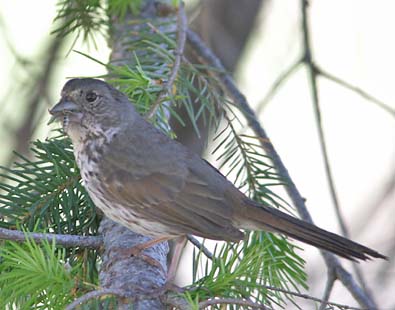
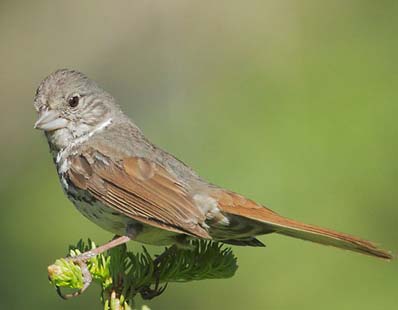
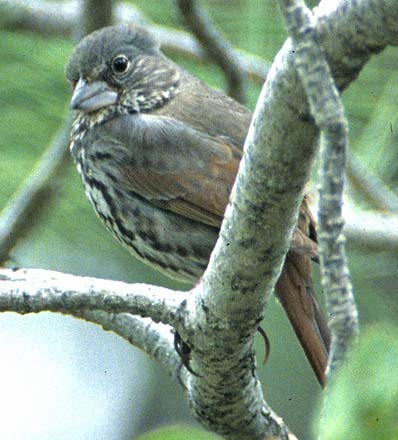
 In
Monterey County there are at least four specimens that have been
assigned to the Thick-billed group, including this one (left) at Museum
of Vertebrate Zoology, taken at 2700' elevation at the head of Turner
Creek on 15 Sep 1934. It shows the big bill, gray back and red tail so
typical of Thick-billed Fox Sparrows. Alden H. Miller assigned it to
race brevicauda. Another similar specimen was collected on 15 Oct 1940 in Carmel Valley.
In
Monterey County there are at least four specimens that have been
assigned to the Thick-billed group, including this one (left) at Museum
of Vertebrate Zoology, taken at 2700' elevation at the head of Turner
Creek on 15 Sep 1934. It shows the big bill, gray back and red tail so
typical of Thick-billed Fox Sparrows. Alden H. Miller assigned it to
race brevicauda. Another similar specimen was collected on 15 Oct 1940 in Carmel Valley.  There are two other specimens at MVZ, labeled "megarhyncha"
and collected in late December, which suggests the birds were
wintering. One is from Seaside, the other from Monterey. The latter
specimen, collected 19 Dec 1940, is the middle one at right, between
the MTY brevicauda specimen (above it) and a stephensi specimen (below it). Maybe it is just me, but the bill of that middle specimen just looks way too small to be megarhyncha, although the rest of the plumage seems okay. In general, it looks more like a schistacea Slate-colored Fox Sparrow to me in this photo.
There are two other specimens at MVZ, labeled "megarhyncha"
and collected in late December, which suggests the birds were
wintering. One is from Seaside, the other from Monterey. The latter
specimen, collected 19 Dec 1940, is the middle one at right, between
the MTY brevicauda specimen (above it) and a stephensi specimen (below it). Maybe it is just me, but the bill of that middle specimen just looks way too small to be megarhyncha, although the rest of the plumage seems okay. In general, it looks more like a schistacea Slate-colored Fox Sparrow to me in this photo.